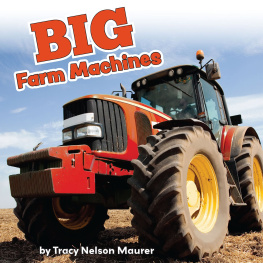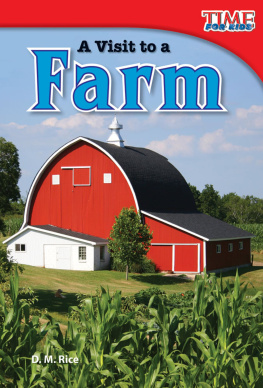PREFACE
More mechanical knowledge is required on the farm than in any other line of business. If a farmer is not mechanically inclined, he is under the necessity of employing someone who is.
Some farms are supplied with a great many handy contrivances to save labor. Farmers differ a great deal in this respect. Some are natural mechanics, some learn how to buy and how to operate the best farm machinery, while others are still living in the past.
Some farmers who make the least pretensions have the best machinery and implements. They may not be good mechanics, but they have an eye to the value of labor saving tools.
The object of this book is to emphasize the importance of mechanics in modern farming; to fit scores of quick-acting machines into the daily routine of farm work and thereby lift heavy loads from the shoulders of men and women; to increase the output at less cost of hand labor and to improve the soil while producing more abundantly than ever before; to suggest the use of suitable machines to manufacture high-priced nutritious human foods from cheap farm by-products.
Illustrations are used to explain principles rather than to recommend any particular type or pattern of machine.
The old is contrasted with the new and the merits of both are expressed.
THE AUTHOR.
CHAPTER I
THE FARM SHOP WITH TOOLS FOR WORKING WOOD AND IRON
FARM SHOP AND IMPLEMENT HOUSE
The workshop and shed to hold farm implements should look as neat and attractive as the larger buildings. Farm implements are expensive. Farm machinery is even more so. When such machinery is all properly housed and kept in repair the depreciation is estimated at ten per cent a year. When the machines are left to rust and weather in the rain and wind the loss is simply ruinous.
More machinery is required on farms than formerly and it costs more. Still it is not a question whether a farmer can afford a machine. If he has sufficient work for it he knows he cannot afford to get along without it and he must have a shed to protect it from the weather when not in use.
In the first place the implement shed should be large enough to accommodate all of the farm implements and machinery without crowding and it should be well built and tight enough to keep out the wind and small animals, including chickens and sparrows.
The shown herewith is twenty-four feet in width and sixty feet in length.
Fig. 1
Figure 1.Perspective View of the Farm Shop, Garage and Implement Shed. The doors to the right are nearly 12 feet high to let in a grain separator over night, or during the winter, or a load of hay in case of a sudden storm.
Fig. 2
Figure 2.Floor Plan of Shop, Garage and Storage. The building is 60 feet wide and 24 feet from front to back. The doors of the garage and tool shed are made to open full width, but 8 feet is wide enough for the shop door. All doors open out against posts and are fastened to prevent blowing shut. The work shop is well lighted and the stationary tools are carefully placed for convenience in doing repair work of all kinds. The pipe vise is at the doorway between the shop and garage so the handles of the pipe tools may swing through the doorway and the pipe may lie full length along the narrow pipe bench.
The doorways provide headroom sufficient for the highest machines, and the width when the double doors are opened and the center post removed is nearly twenty feet, which is sufficient for a binder in field condition or a two-horse spring-tooth rake.
One end of the building looking toward the house is intended for a machine shop to be partitioned off by enclosing the first bent. This gives a room twenty feet wide by twenty-four feet deep for a blacksmith shop and general repair work. The next twenty feet is the garage. The machine shop part of the building will be arranged according to the mechanical inclination of the farmer.
Fig. 3
Figure 3.Perspective View of Farm Implement Shed and Workshop.
A real farm repair shop is a rather elaborate mechanical proposition. There is a good brick chimney with a hood to carry off the smoke and gases from the blacksmith fire and the chimney should have a separate flue for a heating stove. Farm repair work is done mostly during the winter months when a fire in the shop is necessary for comfort and efficiency. A person cannot work to advantage with cold fingers. Paint requires moderate heat to work to advantage. Painting farm implements is a very important part of repair work.
A good shop arrangement is to have an iron workbench across the shop window in the front or entrance end of the building. In the far corner against the back wall is a good place for a woodworking bench. It is too mussy to have the blacksmith work and the carpenter work mixed up.
Fig. 4
Figure 4.Floor Plan of Farm Implement Shed, showing the workshop in one end of the building, handy to the implement storage room.
Sometimes it is necessary to bring in a pair of horses for shoeing, or to pull the shoes off. For this reason, a tie rail bolted to the studding on the side of the shop near the entrance is an extra convenience.
In a hot climate a sliding door is preferable because the wind will not slam it shut. In cold climates, hinge doors are better with a good sill and threshold to shut against to keep out the cold. Sometimes the large door contains a small door big enough to step through, but not large enough to admit much cold, when it is being opened and shut. Likewise a ceiling is needed in a cold country, while in warmer sections, a roof is sufficient. Farm shops, like other farm buildings, should conform to the climate, as well as convenience in doing the work. A solid concrete floor is a great comfort. And it is easily kept clean.
The perspective and floor plan show the arrangement of the doors, windows and chimney and the placing of the work benches, forge, anvil, toolbench and drill press.
show the perspective and floor plan of a farm shop and implement house 40 x 16 feet in size, which is large enough for some farms.
SHOP TOOLS
Good tools are more important on a farm than in a city workshop for the reason that a greater variety of work is required.












